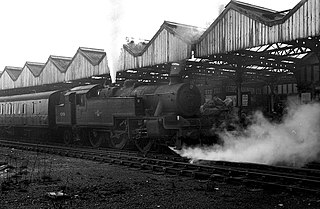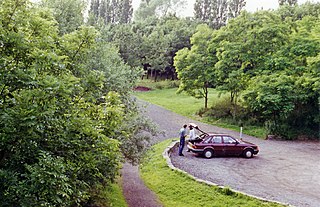Walton on the Hill railway station was located on the Huskisson branch of the North Liverpool Extension Line at the junction of Rice Lane and Queens Drive in Walton, Liverpool, England.

Wigan Central railway station was a railway station near the centre of Wigan, Lancashire, England.

Hindley South railway station served the communities of Hindley and Platt Bridge, south-east of Wigan, England.

The Lancashire Union Railway ran between Blackburn and St Helens in Lancashire, England. It was built primarily to carry goods between Blackburn and Garston Dock on the River Mersey, and also to serve collieries in the Wigan area. Most of the line has now closed, except for the St Helens-to-Wigan section that forms part of the main line between Liverpool and the North.
Appleton railway station served a primarily industrial area of Widnes, England. It was located on the southern section of the former St Helens and Runcorn Gap Railway.
Ashton-in-Makerfield railway station was a railway station serving the town of Ashton-in-Makerfield, although it was located in the neighbouring village of Haydock, formerly in Lancashire, England.
Crank Halt was a railway station serving the village of Crank, Merseyside, England on the St Helens to Rainford Junction then Ormskirk line.

The railway system in Wigan started development in the 19th century during the Industrial Revolution. The first railway built in the town was the Wigan Branch Railway which was opened on 3 September 1832 to serve the many collieries in the area; this was a branch line of the Liverpool and Manchester Railway, the first inter-city railway. By the turn of the 20th century, Wigan had numerous railway stations widely available across the borough, used by both freight and passengers. Many of the lines were originally built for freight which were later converted, as the owners saw the profitability of allowing passengers, to carry passenger trains.
Leigh was a railway station in Bedford, Leigh, Greater Manchester, England, United Kingdom on the London and North Western Railway. Leigh was in the historic county of Lancashire. Its station opened as Bedford Leigh in 1864, was renamed Leigh & Bedford in 1876 and Leigh in 1914. The station closed in 1969.

Culcheth railway station served the village of Culcheth, Warrington, then in Lancashire, later in Cheshire, England. It was situated immediately west of the bridge whereby Wigshaw Lane crossed the railway.

Amberswood (Hindley) railway station was in Hindley, Wigan on the Whelley Loop section of the Lancashire Union Railway. The station was situated where the A577 passed under the line.

St Helens Central (GCR) railway station served the town of St Helens, England with passenger traffic between 1900 and 1952 and goods traffic until 1965. It was the terminus of a branch line from Lowton St Mary's.
Widnes Central railway station served the town of Widnes, England from 1879 to 1964.
Tanhouse Lane railway station is a closed station on the former Sheffield and Midland Railway Companies' Committee line, which formed a loop off the Cheshire Lines Committee (CLC) line in the Widnes area between Liverpool Central and Manchester Central. It was opened on 1 September 1890 as "Tanhouse", being changed later to "Tanhouse Lane". It closed on 5 October 1964.
Farnworth & Bold railway station served the Farnworth area of Widnes, England. The station was on the southern section of the St Helens and Runcorn Gap Railway which was later absorbed by the London and North Western Railway.
Haydock railway station served the village of Haydock, formerly in Lancashire, now in Merseyside, England.

Golborne North railway station served the town of Golborne, in the Metropolitan Borough of Wigan, Greater Manchester, England.
Lowton St Mary's railway station served the scattered community of Lowton, then in Lancashire, now in Greater Manchester, England. It was situated immediately south of the A572 bridge over the tracks.

Bickershaw and Abram railway station served the communities of Bickershaw and Abram southeast of Wigan, England.

The West Leigh and Bedford railway station served the hamlet of Crankwood, the village of Abram, and the Plank Lane area of Leigh, England. Like many railways, the line passed between rather than through communities, with branches off to serve the key driver - goods, and in this area - coal.







